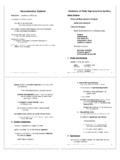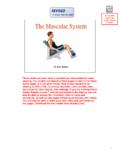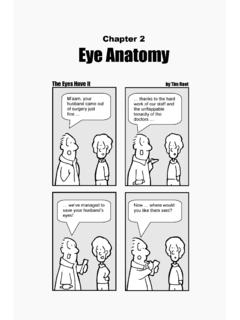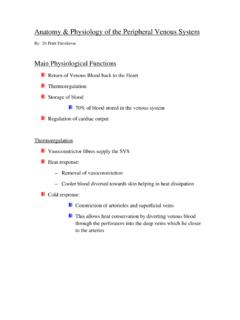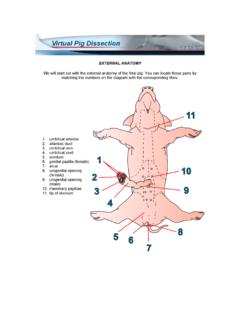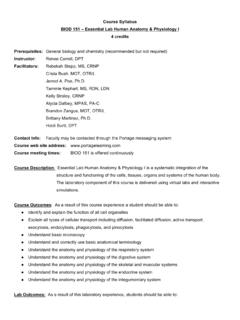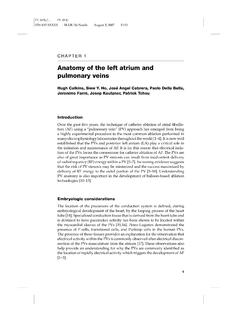Transcription of Essentials of Human Anatomy & Physiology - …
1 Hole s Essentials of HumanAnatomy & PhysiologyDavid ShierJackie ButlerRicki LewisCreated by Dr. Melissa Eisenhauer Head Athletic Trainer/Assistant Professor Trevecca Nazarene UniversityAmended by John CrockerChapter 1 Lecture Outlines*Copyright The McGraw-Hill Companies, Inc. Permission required for reproduction or Science 15 Biological Science 15::Survey of Human Anatomy and PhysiologySurvey of Human Anatomy and PhysiologySpring 2009 Spring 2009 Monday and Wednesday 8:45 Monday and Wednesday 8:45 10:5010:50LS101LS101 Instructor: John Crocker phone (408) 852 Instructor: John Crocker phone (408) 852--2835 Email: 2835 Email: LS117 Office: LS117 Office Hours: Wednesday 11:00 Office Hours: Wednesday 11:00--12:00 or by appointment12:00 or by appointmentRequired Texts:Required Texts:Hole's Essentials of Human Anatomy and PhysiologyHole's Essentials of Human Anatomy and PhysiologyHole's Essentials of Human Anatomy and Physiology Lab ManualHole's Essentials of Human Anatomy and Physiology Lab ManualMcKenna, McKenna, Supplement for Biology 15 Supplement for Biology 15 Supplemental Texts / Materials:Supplemental Texts / Materials.
2 Study Guide for Hole's Essentials of A &PStudy Guide for Hole's Essentials of A &PRust, A Guide to Anatomy and PhysiologyRust, A Guide to Anatomy and PhysiologyMcMinn, Color Atlas of Human AnatomyMcMinn, Color Atlas of Human AnatomyColoring Atlas for A&PColoring Atlas for A&PNetter's Anatomy FlashcardsNetter's Anatomy FlashcardsPermachartsPermacharts(or other brand plastic study sheets)(or other brand plastic study sheets) Muscular Attachments. Skeletal System, Nervous System, Articulations3 Expected Course Learning OutcomesExpected Course Learning Outcomes1. Identify selected structures of the Human body1. Identify selected structures of the Human body2. List the organ systems of the Human body and explain their 2. List the organ systems of the Human body and explain their functions functions 3. Relate the structures of the Human body to their functions. 3. Relate the structures of the Human body to their functions.
3 4. Develop basic laboratory and dissection, skills which can be4. Develop basic laboratory and dissection, skills which can beutilized in further in further Apply knowledge of structure and function learned at one lev5. Apply knowledge of structure and function learned at one level el or system to other levels or systems. or system to other levels or systems. Measure: written exam, homework, lab reportsMeasure: written exam, homework, lab reports4 Grading PolicyGrading PolicyLecture (~67%): 4 exams at 100 points each Lecture (~67%): 4 exams at 100 points each 400400 HomeworkHomework~50~50 Final ExamFinal Exam100100 Laboratory (~33%) Lab reportsLaboratory (~33%) Lab reports100100 Lab QuizzesLab Quizzes~80~80 Lab FinalLab Final100100 Total ~ 830 Total ~ 830A= 90% and up (AA= 90% and up (A--= )= )NRS= withdrawal during weeks 1 NRS= withdrawal during weeks 1--5 5 B= 80B= 80--89% (B+87; B89% (B+87.))
4 W= withdrawal during weeks 6W= withdrawal during weeks 6--14 14 C= 70C= 70--79% (C+=77)79% (C+=77)F= failure to notify instructor of withdrawalF= failure to notify instructor of withdrawalD= 60D= 60--69%69%or withdrawal after week 14or withdrawal after week 14F= less than 60%F= less than 60%I= incomplete (for unforeseen and I= incomplete (for unforeseen and justifiable reasons, or emergency; may be justifiable reasons, or emergency; may be granted only after week 14 granted only after week 14 5 Special Concerns:Special Concerns:Students with special needs such as hearing and/or Students with special needs such as hearing and/or vision impairment should make arrangements with the vision impairment should make arrangements with the ADA Accommodation Statement:ADA Accommodation Statement:Students requiring special services or arrangements Students requiring special services or arrangements because of hearing, visual or other disability should because of hearing, visual or other disability should contact their instructor, counselor, or the disabled contact their instructor, counselor, or the disabled Student Service Service Official note takers are neededOfficial note takers are needed Please contact Mr.))
5 Crocker after class if you are Please contact Mr. Crocker after class if you are interestedinterested7 Initial QuizInitial the terms Anatomy and the terms Anatomy and the levels of organization of the Human Body from least comList the levels of organization of the Human Body from least complex to plex to most complex (minimum of 7 levels).most complex (minimum of 7 levels). characteristics are shared by all living organisms?What characteristics are shared by all living organisms? the three primary building blocks of atoms?List the three primary building blocks of atoms? are the two types of cell division and what is the primary What are the two types of cell division and what is the primary difference difference between them?between them? 2 functions of 2 functions of at least 3 functions of the at least 3 functions of the the 3 types of the 3 types of the 3 types of blood cells and their primary the 3 types of blood cells and their primary and how does digestion begin?
6 Where and how does digestion begin?Chapter 1 Chapter 1 Introduction to Human Introduction to Human Anatomy and PhysiologyAnatomy and Physiology9 Introduction:Introduction: The early students of Anatomy and Physiology The early students of Anatomy and Physiology were most likely concerned with treating illnesses were most likely concerned with treating illnesses and injuries. and injuries. Early healers relied on superstitions and magic. Early healers relied on superstitions and magic. Later, herbs were used to treat certain , herbs were used to treat certain ailments. Eventually, after much controversy the study of Eventually, after much controversy the study of medicine with standardized terms in Greek and medicine with standardized terms in Greek and Latin and PhysiologyAnatomy and Physiology AnatomyAnatomydeals with the structure deals with the structure (morphology) of the body and its parts; in (morphology) of the body and its parts; in other words, what are things called?
7 Other words, what are things called? PhysiologyPhysiologystudies the functions of these studies the functions of these parts or asks the question, parts or asks the question, how do they how do they work?work? The two disciplines are closely interrelated The two disciplines are closely interrelated because the functional role of a part depends because the functional role of a part depends on how it is how it is Anatomists rely on observation and Anatomists rely on observation and dissection, while physiologists employ dissection, while physiologists employ It is more common to discover new It is more common to discover new information about Physiology but information about Physiology but anatomical discoveries are being made anatomical discoveries are being made as of Organization:Levels of Organization:13 Levels of Organization:Levels of Organization:The Human body is the sum of its parts and The Human body is the sum of its parts and these parts can be studied at a variety of levels these parts can be studied at a variety of levels of the simplest the simplest or more atoms comprise a Two or more atoms comprise a large, biologically are large, biologically important molecules inside molecules inside aggregates of are aggregates of macromolecules used to carry out a specific macromolecules used to carry out a specific function in the in the of Organization Continued.
8 Levels of Organization the basic living the basic living groups of cells functioning are groups of cells functioning of tissues form Groups of tissues form of organs function together as Groups of organs function together as organ systemsorgan systems functioning together make Organ systems functioning together make up an up an organismorganism.. 15 Characteristics of LifeCharacteristics of Life Fundamental characteristics of life are Fundamental characteristics of life are traits shared by all shared by all of life include:Characteristics of life (internal or gross)(internal or gross) (reaction to internal or external (reaction to internal or external change)change) (increase in size without change in shape)(increase in size without change in shape) (new organisms or new cells)(new organisms or new cells) (use of oxygen; removal of CO(use of oxygen; removal of CO22))Table (breakdown of food into simpler (breakdown of food into simpler forms)forms) (movement of substances through (movement of substances through membranes and into fluids)membranes and into fluids) (movement within body fluids)(movement within body fluids) (changing nutrients into chemically (changing nutrients into chemically different forms)different forms) (removal of metabolic wastes)(removal of metabolic wastes) Taken together, these 10 characteristicsTaken together, these 10 characteristicsconstitute constitute of LifeMaintenance of LifeRequirements of OrganismsRequirements of Organisms:: Life depends on the availability of the following:Life depends on the availability of the Water Heat Pressure Both the quality and quantity of these factors are Both the quality and quantity of these factors are important.
9 Important. 19 Maintenance of a stable internal environment is called Maintenance of a stable internal environment is called Homeostasis is regulated through control systems which Homeostasis is regulated through control systems which have have receptorsreceptors, a , a set pointset pointand and effectors effectors in common. in common. Examples include:Examples include:a. a. Homeostatic mechanisms regulate body Homeostatic mechanisms regulate body temperature in a manner similar to the functioning of temperature in a manner similar to the functioning of a home heating home heating homeostatic mechanism employs pressureAnother homeostatic mechanism employs pressure--sensitive receptors to regulate blood receptors to regulate blood :Homeostasis:20 Many of the body's homeostatic controls Many of the body's homeostatic controls are are negative feedbacknegative Each individual uses homeostatic Each individual uses homeostatic mechanisms to keep body levels within mechanisms to keep body levels within a normal range; normal ranges can vary a normal range.
10 Normal ranges can vary from one individual to the one individual to the Major features of the Human body include its Major features of the Human body include its cavities, membranes, and organ , membranes, and organ of the Human BodyOrganization of the Human Body22 Body Cavities:Body Cavities: The body can be divided into an The body can be divided into an appendicularappendicularportion portion (upper and lower limbs) and an (upper and lower limbs) and an axialaxialportion (head, portion (head, neck, and trunk), which includes a neck, and trunk), which includes a dorsaldorsaland a and a ventral ventral cavity. Organs within these cavities are called cavity. Organs within these cavities are called dorsalThe dorsalcavity can be divided into two cavity can be divided into two areas:areas:1)1)Cranial cavityCranial cavity2)2)Vertebral canalVertebral canalb.


